Innovation Management at most companies is broken. Here’s how we’re fixing it.
At most corporations, the responsibility of “innovation” used to be limited to specific departments in the organization, such as R&D, product, or marketing. But over the past decade, we’ve seen more and more enterprises realize that they need a dedicated department or team spearheading innovation in order to stay competitive.
These initiatives usually come with top-level goals of “building an innovation culture” and leveraging the brainpower and creativity of all employees, not just those in specific departments like R&D. The most dedicated companies end up building innovation management departments with dedicated roles as high as Chief Innovation Officer.
In our experience consulting for over 10 years with corporations trying to formalize collaboration and innovation activities, these motivations are good — and the underlying reasons for wanting to be deliberate about innovation management in order to stay competitive are absolutely sound.
However, we’ve noticed that despite well-meaning desires to create an innovation culture and have thriving innovation departments with good, competent, and well-intentioned people, most innovation programs are handcuffed by poor execution. How is this possible?
This stems from a fundamental misunderstanding of what the innovation management process needs to work. Specifically, most companies don’t understand the importance of the full lifecycle of innovation (i.e. taking ideas from conception to implementation) and over-index the idea collection step.
That is, they think that asking employees to submit ideas on any topic — be it new product ideas, operational ideas, or employee experience ideas — counts as having an innovation process. Employees submit ideas to an email address or a web form, and the employee has little to no visibility on what happens to the idea after that (and often little to nothing happens to most ideas submitted).
Let us be clear: idea collection is not innovation management. It’s a part of innovation management, but it’s absolutely not enough.
A thriving innovation management program also needs to include:
A process for giving feedback on ideas
A process for revising and iterating on ideas (rarely is an idea “fully baked” on first draft)
A process for evaluating and screening ideas
A process for testing ideas before implementation (to avoid failure to launch and costly mistakes)
Visibility for all employees throughout this process (when desired)
Configurability of these processes for different types of ideas (e.g., new products vs. operational improvements)
These may seem like secondary concerns after idea collection, but they’re not. As we’ll explain in detail below, ideas are never implemented or launched in their original form. No idea stays untouched between collection and implementation, and — this is crucial — many different stakeholders, not just innovation managers, will have crucial feedback on ideas that are critical to their eventual success. In this way, innovation, by its very nature, is a process of collaboration that takes original ideas and iterates on them to turn them into “shippable” products or processes.
So, in order to cultivate this, you need systems and processes by which employees can collaborate not just on idea generation but also on idea evaluation, revision, validation, and more. Your systems need to support, encourage, and even automate these steps in order to really maximize employee capital and create what so many companies desire: a culture of innovation.
We learned this over a decade ago when we were consulting on collaboration and innovation at large companies and tasked with finding tools to help them. We couldn’t find a solution that could support all these different aspects of innovation management, so we ended up building it ourselves. That became what is now InnovationCast.
Below, we’ll share our story and detail the steps required to build a well-functioning innovation management process based on our 10+ years of experience working with multinational corporations on setting up innovation departments and processes. Finally, we’ll explain how we designed and refined InnovationCast over the past 7 years to support these steps.
Our Story: Learning the All-Too-Common Mistakes Companies Make in Innovation Management
As we touched on above, we discovered these issues with typical innovation management when we were consulting with corporations to help them implement collaboration solutions. Since internal collaboration is an important component of innovation, some clients eventually asked us to help build a toolset that could help them formalize an innovation management process.
When we were asked to do this, we found that none of the existing tools in the innovation management space had what our clients needed to support the full lifecycle of innovation. They were mostly just idea collection tools (notably, this is still largely true today).
Companies would use these idea collection tools or their home-built webforms, inboxes, and spreadsheet systems to collect ideas. But we learned that the vast majority of these ideas would sit untouched after submission. This is because the only people with access to the full list of ideas were the core innovation team administrating the process, and in large corporations, it’s simply impossible for these teams (of usually fewer than 10) to process the number of ideas generated.
Even more difficult was giving feedback and working with the original authors of these ideas to iterate and evaluate them all the way through implementation. Doing this properly requires more than just the innovation management department or team. It requires opening up the innovation process to the wider company, so any employee can contribute ideas, see others’ ideas, ask questions, give feedback, revise ideas, and more. Doing this properly is true innovation management.
Because we didn’t find a system or solution that supported this full lifecycle, we built our own. We have since implemented it across dozens of large and small corporations, government offices, universities, and other organizations looking to be intentional, thoughtful, and productive with innovation initiatives. These include organizations like DHL, Novo Nordisk, Siemens, Florida Department of Transportation, and more.
We’ve also been recognized by organizations like Forrester (Groundswell Award — Best Innovation Program), Gartner (featured in multiple Gartner reports), Nielsen Norman Group (Top 10 Best Intranet User Experiences for our implementation with Mota-Engil, an engineering and construction company), and more.
The Required Steps and Best Practices of a Thriving Innovation Management Process
From all of our years helping companies set up innovation management processes, here are the steps we’ve learned are essential if you want a proper, productive innovation management process.
Step 1: Idea Collection
Even though idea collection is the most commonly-practiced part of the innovation management process, it still suffers from poor execution.
Namely, many idea collection processes are what we call a “digital suggestion box” — meaning there’s just an email address or web form with an open call to submit ideas on a given topic.
That’s a good start but suffers from several problems:
They get stale over time. Employees have no motivation to submit ideas by a certain time so they procrastinate.
They often lack context and relevance. An entire department can have an ideas@department.company.com email address; employees are just asked to submit ideas as they have them. These usually end up being random ideas that aren’t necessarily tied to current organizational goals.
They lack visibility. The submitted ideas are only seen by a select team of managers, so employees have no idea if their ideas were read or considered. This reduces overall engagement and morale to keep submitting ideas — an innovation culture killer.
In order to solve these problems, we designed idea collection in InnovationCast with a few key features.
First, our software encourages teams to collect ideas via challenges, not just an open inbox to submit ideas at any time. Challenges are time-bound solicitations of ideas and are one of our most used features. They come with an explanation of what is being asked, why, and how it will help the company. Whoever is creating the challenge can use images, videos, or anything else to explain the current problems, what kinds of ideas they’re looking for, and much more in detail.
This, by itself, can dramatically improve the quality of ideas compared to the open digital suggestion box approach that is so common.
Here’s an example of what a challenge page inside InnovationCast can look like for a hypothetical healthcare company asking for ideas on how to use a new type of medical technology to improve their services:
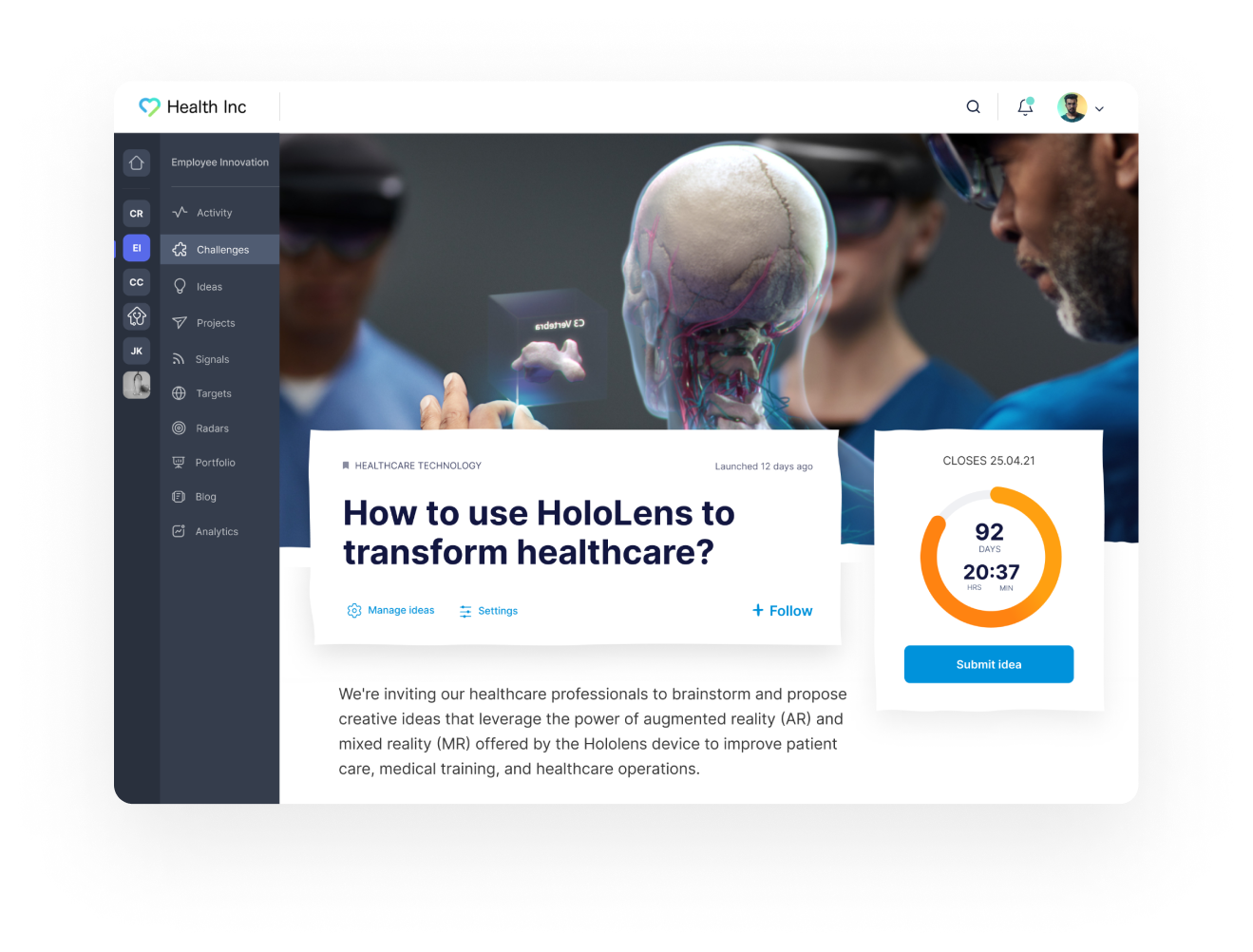
In addition to getting better ideas by providing more context, the time-bound nature also gives a sense of urgency for employees to submit ideas. We encourage almost all companies we work with to use challenges for idea collection because they work far more effectively than an always-open call to submit ideas.
In addition, employees using InnovationCast can also submit ideas that aren’t part of an active challenge. But even then, instead of just an open suggestion box-like experience, InnovationCast still asks them to state which category, department, theme, problem area, or channel their idea best fits into.
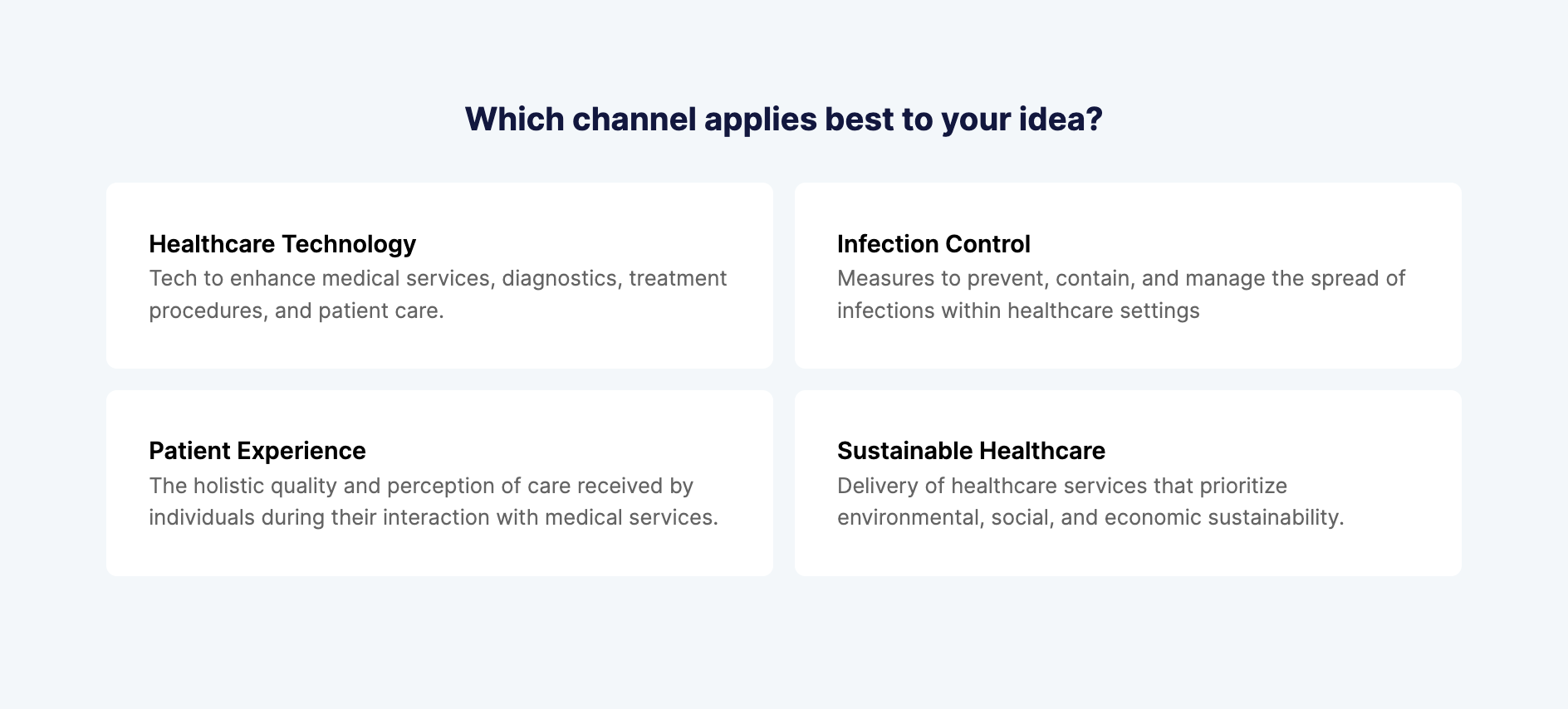 This organizes ideas on the backend and, importantly, alerts the correct people for every idea submitted, which further increases the chances of ideas getting feedback and engagement.
This organizes ideas on the backend and, importantly, alerts the correct people for every idea submitted, which further increases the chances of ideas getting feedback and engagement.
In addition, categorizing ideas also ensures that each one gets sent to the proper workflow for that category, which, as we explain below, is important because different types of ideas in different parts of the company often demand very different idea development workflows or stages.
Step 2: Feedback and Discussion
As we mentioned, solely collecting ideas isn’t innovation management. It’s the collaboration, feedback, and iteration that turns idea generation into innovation management. So having systems that encourage feedback on ideas is essential, and having that feedback come from anyone in the organization, not just the select few managing the process, is equally crucial.
InnovationCast helps with this process in a few ways.
First, there’s the simple fact that all employees can see every idea that’s submitted in InnovationCast.
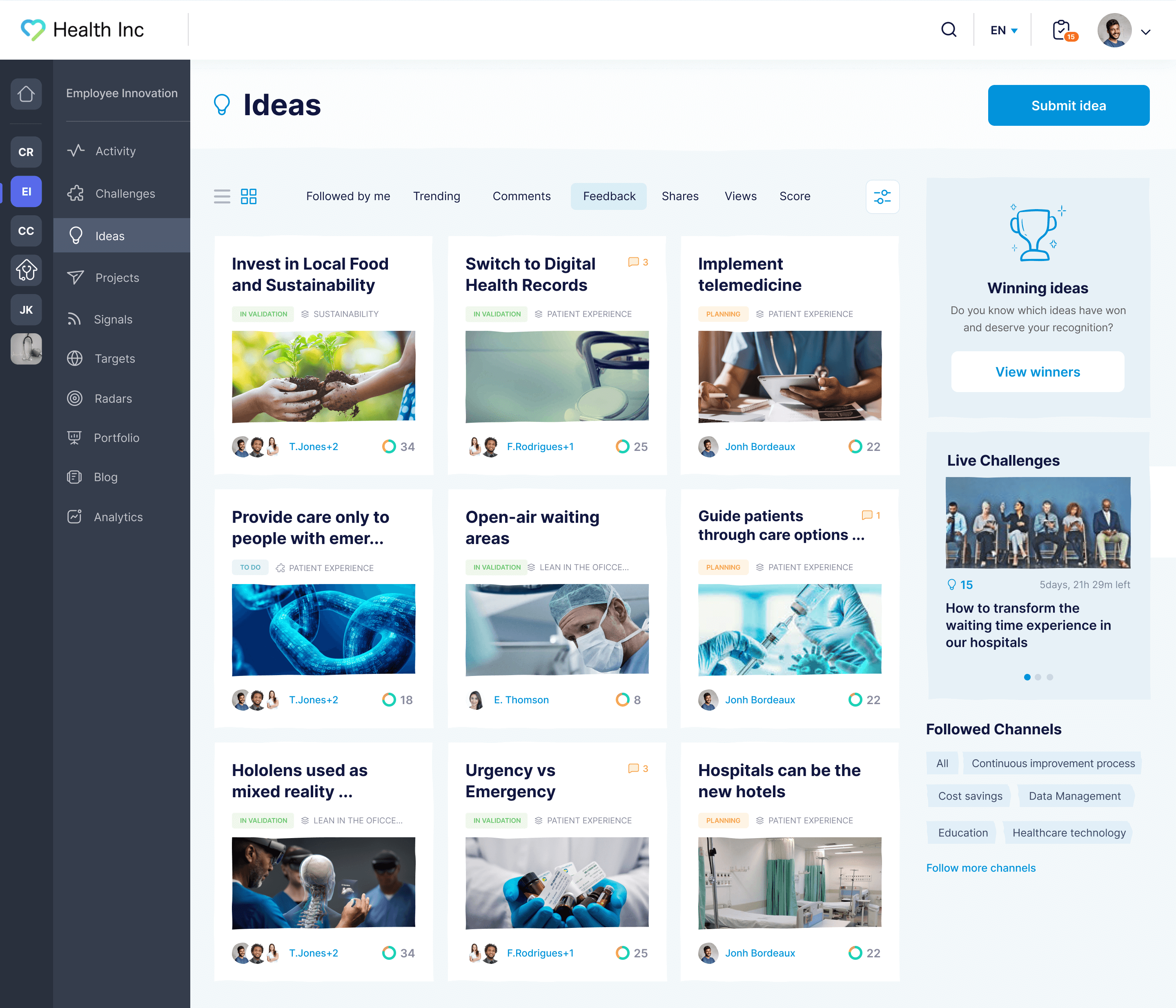
Just the fact that this is possible is a small but extremely important difference from the typical “digital suggestion box” system where there’s just no way for an employee to see others’ ideas, so they can’t really give feedback and no sense of community is built. This approach simply doesn’t build engagement or a collaborative culture.
In contrast, any employee opening up InnovationCast can immediately see an activity feed of the latest ideas, comments, suggestions, and revisions.
 You can see how this immediately feels more like a community where co-workers are collaborating, co-creating ideas, and driving innovation.
You can see how this immediately feels more like a community where co-workers are collaborating, co-creating ideas, and driving innovation.
But to further encourage engagement and feedback, we’ve also built in small but powerful social design features such as a “Follow” and “Share” on every challenge (highlighted below):
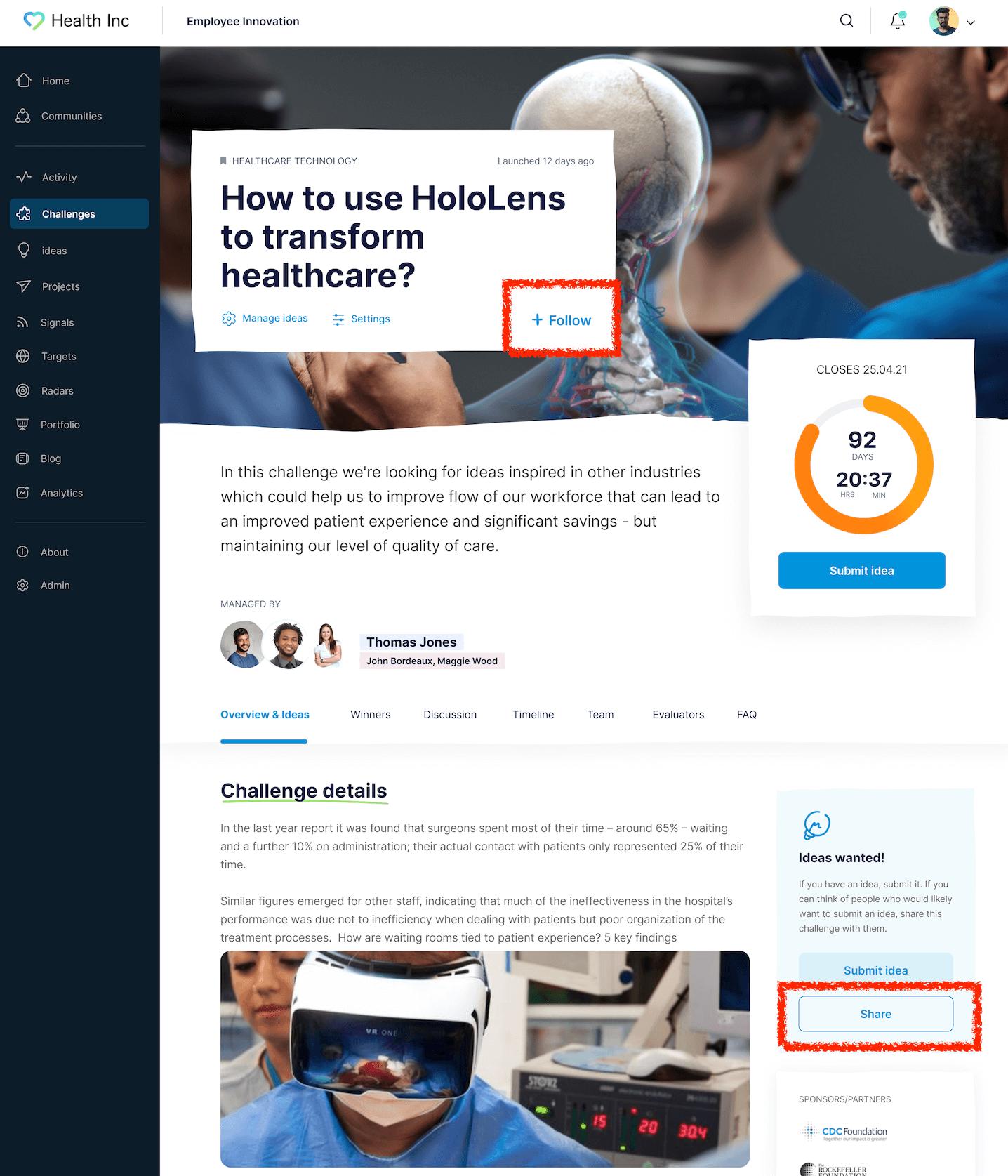
You can follow both a challenge and an idea, which lets employees who may not have their own ideas to submit stay engaged. This way, they’ll get notifications when new ideas, updates, or discussions are submitted about an idea they are following, which heavily increases the chances of them contributing to the discussion as well.
We also have carefully designed prompts asking employees to improve or evaluate ideas.

We’ve been very intentional in our social design. For example, instead of just letting people “like” or “vote” for an idea, we ask why when they vote. This simple act of asking why helps avoid employees just going through and mindlessly clicking “Looks great” on every idea. It ensures that the feedback is more thoughtful and authentic and substantively contributes to the discussion:
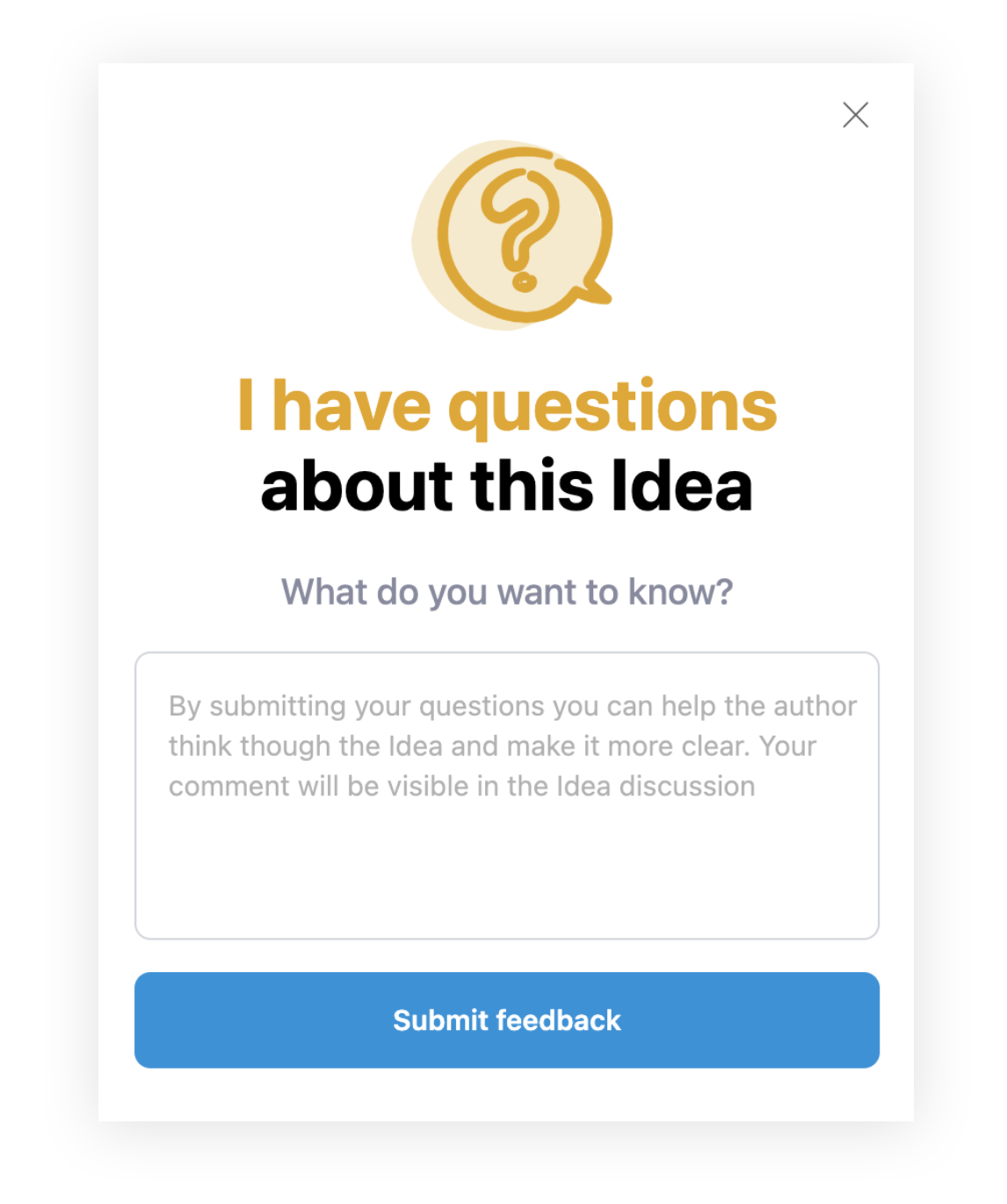
We’ve found this to be an incredibly effective way of engaging employees who may not have any ideas to submit of their own, but who may be curious about or can contribute to refining or giving feedback on other employees’ ideas.
Once any employee submits feedback, the original author of the idea is notified and can reply so that a discussion ensues.
Finally, the original author of the idea can mark any piece of feedback that they found particularly helpful or that encouraged them to revise their idea as a “significant contribution.” When doing so, the author is asked to specify why it was a significant contribution. Then, the idea is highlighted in green in the feedback section — giving clear visual recognition to the feedback and its author.

This is just a sampling of the features we’ve intentionally designed into InnovationCast to transform idea collection from a solo, one-time activity (submit an idea, and that’s it) into a collaborative, community-building activity that the entire organization participates in.
More than anything else, this process shift is what helps create a culture of innovation.
Step 3: The Idea Assessment Workflow
Once ideas are submitted and initial discussion and feedback is given, the other big component of InnovationCast is facilitating the idea assessment and validation workflow.
Here is an example workflow for new product ideas with six stages in InnovationCast:
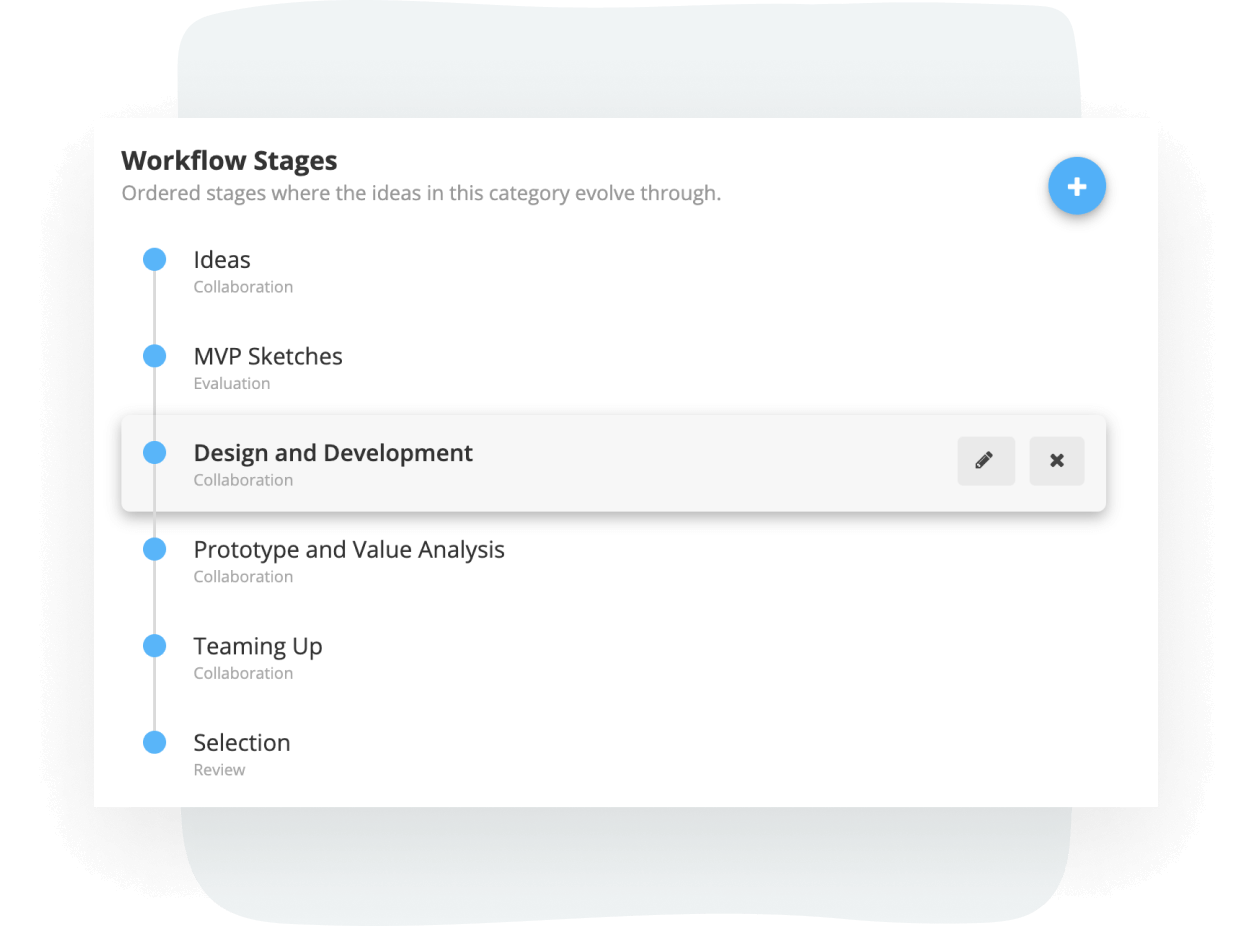
Notably, these stages aren’t just simple “statuses”, like with an IT ticket. Our core beliefs in collaboration and community being critical to innovation management are built into how idea workflows work in Innovationcast.
Namely, each stage can be configured to have specific next actions attached to it (such as MVP sketches for new software ideas, like in the example above) and to notify specific people responsible for each step. For example, the MVP sketches step above may need to involve decision-makers in design, UX, and product teams. With InnovationCast, the moment a new MVP sketch is uploaded, those stakeholders would be automatically notified. In addition, that step can be set up to have its own set of criteria, questions, assessment surveys, required files, and more that need to be completed for the idea to move forward.
Compare this with typical idea capture software or homegrown systems using project management software or spreadsheets. In those systems, there’s typically only a single thread of comments through the entire lifecycle of that idea.
But different stages often need dramatically different actions. Screening requires screening questions answered by an evaluator. A business case step may require extensive financial analysis. A refinement requires the author to revise their original document, and evaluators to discuss those refinements and more.
We even support complex next steps for ideas like hypotheses and experiments, where people can make hypotheses about how the idea will fair in different scenarios or other details of the idea and design experiments to test these hypotheses:

Or contributors can list our assumptions that must underlie an idea for it to be true or for it to positively contribute to a goal and discuss, validate, or invalidate assumptions:
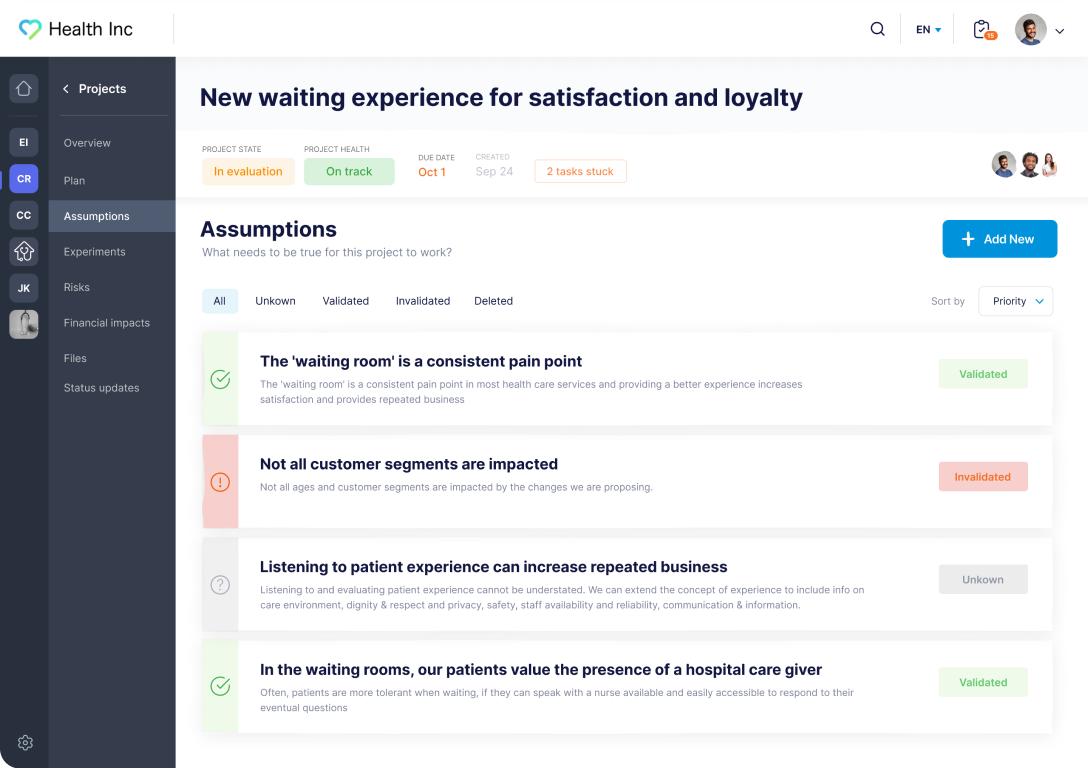
Without going into too much detail about each of these features, know that these are involved, extensive actions that could be required at any stage of the idea workflow.
In our experience (and those of the companies we’ve worked with), these steps can get messy quickly, and company after company has told us that they eventually take the best ideas offline because of this.
Once ideas go “offline,” the organization immediately loses any sense of community and culture because everyone loses visibility on what happens to that idea next. It simply becomes a project that specific teams work on and discuss in their own email or message threads.
In contrast, we significantly enhance visibility and collaboration by centralizing the entire innovation lifecycle within a single, integrated system like InnovationCast. This unified approach ensures access for everyone to the most up-to-date and relevant information. On our platform, anyone can click into an idea and see what stage it’s in. But, importantly, they can also go back to see the history of activity on the idea: all past evaluation criteria and scores, comments, files, documents, assessments, etc.
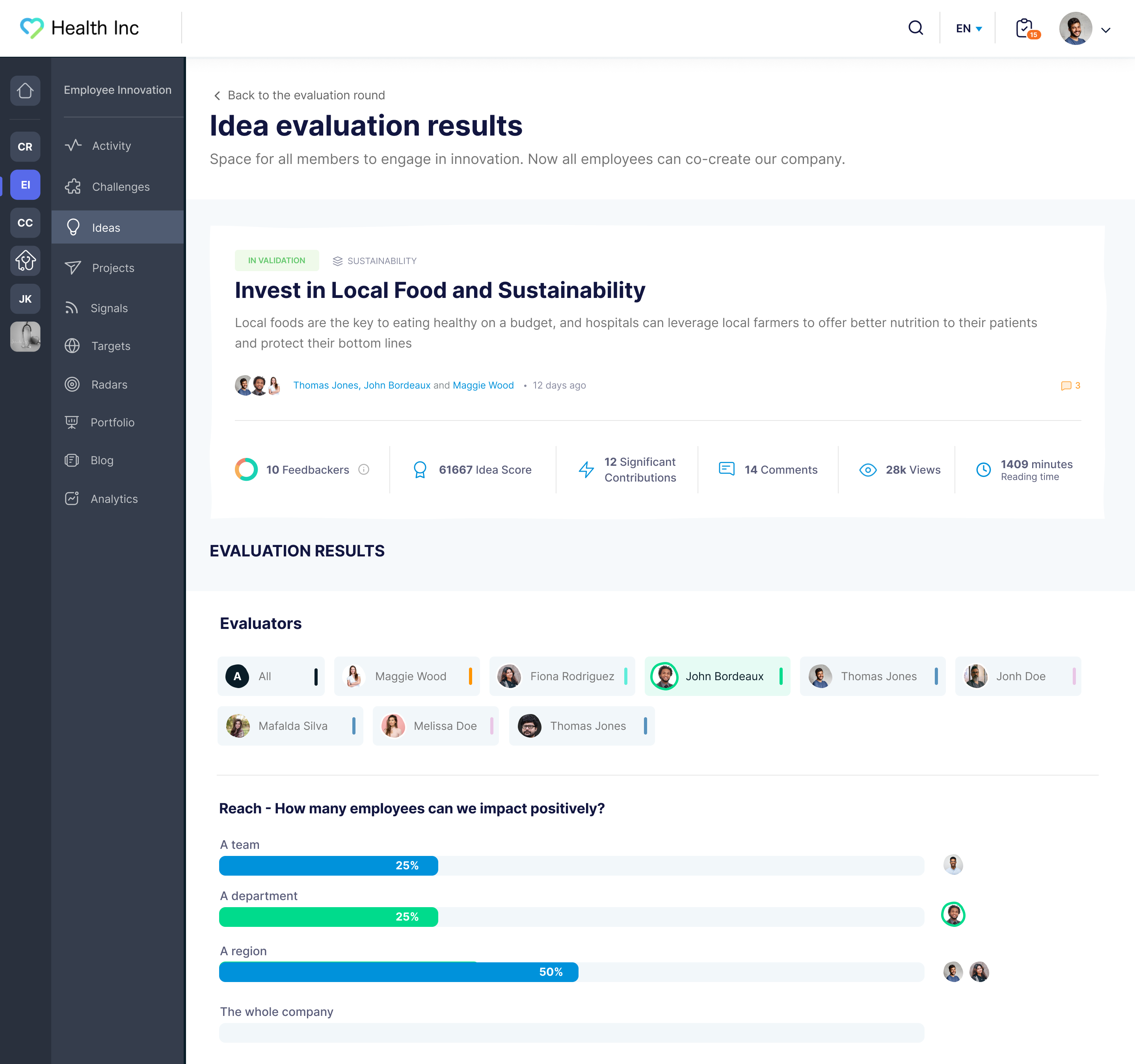
Moreover, by maintaining the idea workflow within a unified system, we can automate the process of idea validation, which prevents ideas from stagnating at any stage of development. Specifically, once an idea progresses to a given stage, such as screening, the relevant evaluators get emailed by the system immediately, and the screening questions are sent to them. Once they’re done, the system alerts the team responsible for the next stage, and so on.
Step 4. Configurability
Finally, an important learning about successful innovation management is that the idea assessment workflow isn’t the same for each type of idea.
For example, even within one company, a new product idea may have to go through a very specific set of steps before a new product gets launched (e.g., proof of concept, business case, etc.). But an operational improvement or employee experience idea may have far fewer steps.
In fact, we’ve found that the ability to configure the idea workflow stages is crucial to a thriving innovation management system.
Let’s take this example workflow for our hypothetical healthcare company:
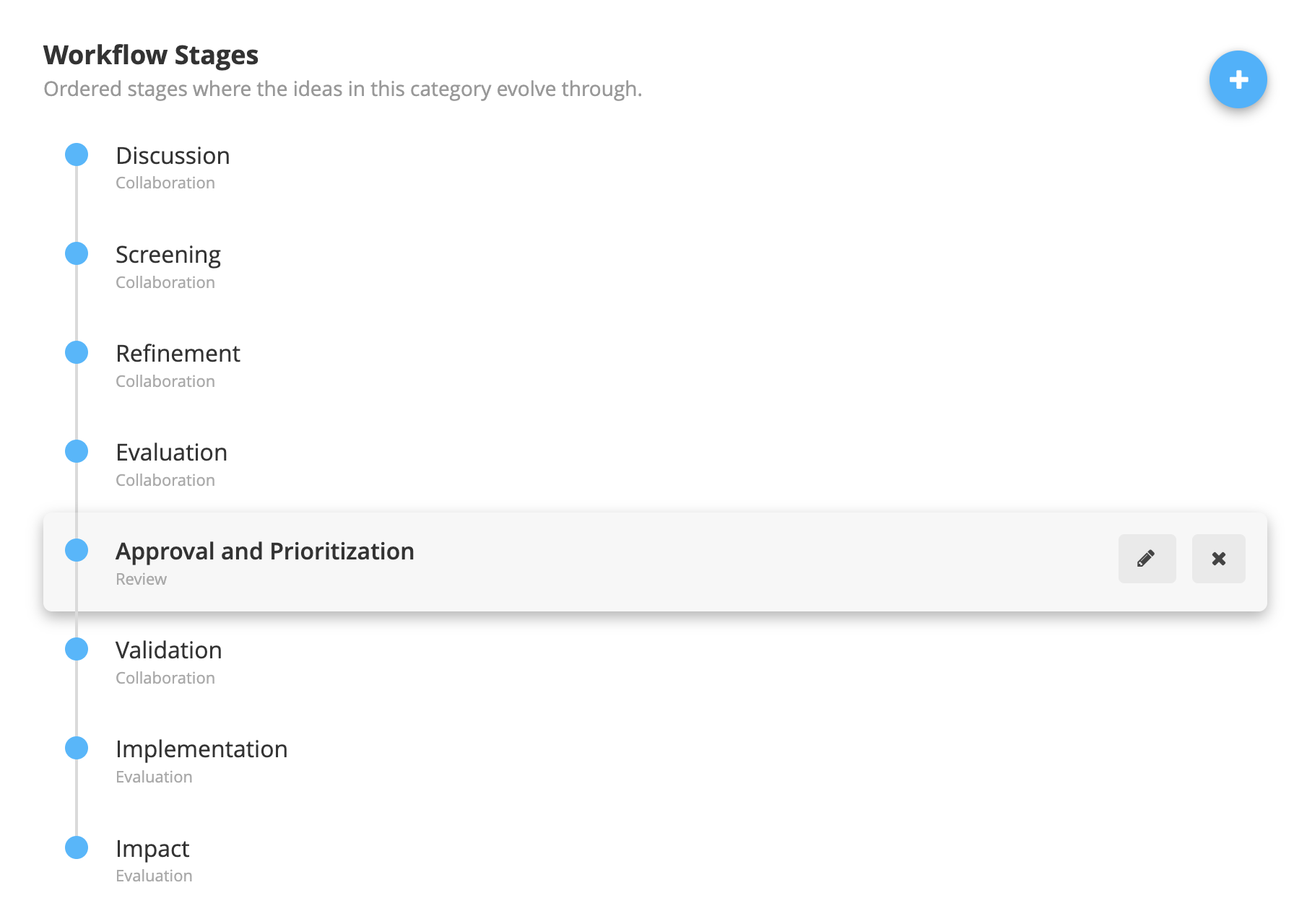 This set of stages could be used for new operational ideas in manufacturing, for example.
This set of stages could be used for new operational ideas in manufacturing, for example.
But what if that same company also has a category of ideas around new software development that happens to have a much smaller and very different idea evaluation workflow? Those ideas may need a workflow like the MVP-based one from above:

This scenario is extremely common. Within an organization, there are almost always multiple different idea evaluation processes for different parts of the company.
Unfortunately, most idea capture or innovation management tools we've evaluated don’t come with this flexibility. You can add or remove evaluation stages but you’re limited to one stage for all idea types. This is impractical and not reflective of the natural way of doing this.
In our experience, forcing different teams and departments into a single idea maturation workflow doesn’t help build an innovation culture: it only alienates teams and departments for which that workflow doesn’t work.
So we’ve intentionally built InnovationCast to be extremely configurable, not just for a single organization but for different teams within a single organization.
See If InnovationCast Is Right for You
We’ve received great feedback since we created InnovationCast. Customers who have tried to implement innovation programs with other tools or homemade solutions have told us InnovationCast is the first tool that has been able to support the innovation management process from start to finish.
Many customers have said they would use a tool for idea collection, but then have to manage the rest of the process (like validating and selecting) offline.
If you think having a thorough innovation management process like the one described above could help your company or team, you can reach out to schedule a demo of InnovationCast.

